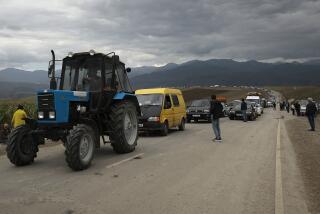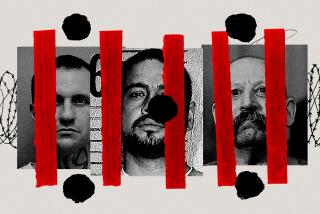The lies of Iran, in pictures
- Share via
On June 20, a young Iranian woman was shot dead at one of the mass protests that followed the contested re- election of President Mahmoud Ahmadinejad. Millions of people around the world watched video of Neda Agha-Soltan hemorrhaging on Tehran’s Karegar Street, and hers became the tragic, beautiful and galvanizing face of the reform movement in Iran.
Witnesses implicated a member of the Basij, the governmental militia, in Agha-Soltan’s death. But an Iranian ambassador and ayatollah quickly pinned her shooting on the CIA and her fellow protesters, while a broadcasting official -- and a government-sponsored documentary that aired last month -- said the death had been simulated by the Western news media and by Agha-Soltan herself.
Thirty years ago, another iconic image of a shooting death in Iran raced round the world. It too triggered a cycle of public protests and creative denials by the then-new Islamist government of Iran.
Those denials foreshadowed how the leaders of the Islamic Republic would react to Agha-Soltan’s death. And they demonstrate how the lies of a government can do nothing to suppress the power of an image.
In August 1979, seven months after the ouster of the shah, the euphoria of revolution had given way to the realities of Islamic fundamentalism -- black chadors, broken wine bottles, censorship, public executions. Protests in Tehran were drawing enormous crowds, while in Kurdistan, separatists were demanding an independent Kurdish state. On Aug. 16, Ayatollah Ruhollah Khomeini dispatched Iranian troops to put down the movement.
The troops had been killing Kurds for 11 days when, on Aug. 27, 11 more “counterrevolutionaries” were sentenced to die in Sanandaj.
Among the condemned were Ahsan and Shahriar Nahid. Ahsan, an engineer in Tehran, had joined a Kurdish separatist organization after the revolution and moved to Sanandaj. Shahriar, a medical student, had been visiting his brother when the two were arrested at a military checkpoint.
Their mother, Monir, raced from Tehran to try and help her sons. She found them under guard in an army hospital and an airport control tower. But when she returned to the latter with a change of clothing, she learned that the young men and nine others had been shot by a firing squad on a dirt airfield. She threw down the Koran she carried in her blouse.
“Min itr Musulman nim,” she said in Kurdish. “I am no longer a Muslim.”
The next afternoon, a photograph of the execution ran in Ettela’at, Iran’s oldest paper. Suddenly, the estimated 500 victims of the ayatollah’s firing squads had a face. Newsstands in Tehran sold out. The next day, the photo ran on the front pages of papers around the world.
A week after the Nahid brothers were buried in Talah Cemetery in Sanandaj, their brother, Farhad, spent his savings to photocopy the picture of their execution; he and friends canvassed Tehran with it. Their mother then brandished the photograph at meetings with Prime Minister Mehdi Bazargan, cleric Mahmoud Taleghani and essayist Haj Seyyed Javadi.
The government did not respond as Monir Nahid had hoped. Sadegh Khalkhali, the judge who had sentenced her sons to death (and granted permission to the Ettela’at photographer to take the photograph), declared on state TV that she had fabricated the photo and that she was related to the sister of the deposed shah. (She wasn’t.) Later, the judge went back on television and declared that the photograph had been forged by Israel. And on Sept. 9, Ahmad Azari Qomi, the prosecuting attorney of the Islamic Revolutionary Council, issued a statement that cited the famous image. It began:
“Following the order of Imam Khomeini . . . journalists should refrain from insertion of bold phrases and headlines, evocative pictures which could incite people.”
On Oct. 8, one day after the brothers’ mother addressed a crowd of students at Tehran University, the police raided her apartment one story above Seyyed Khandan Street. But she had flown at 6 a.m. to Germany on a passport registered under her maiden name. Twenty days later, she flew to the United States. She now lives in Los Angeles.
In April 1980, the photograph won the Pulitzer Prize. The prizewinning photographer, Jahangir Razmi, remained anonymous until, with his permission, I told his story in the Wall Street Journal in 2006. The next year, at a dinner in New York, Nahid embraced the man who had captured her sons’ deaths on film.
Six months ago, Nahid, then 84 years old, watched video of the death of Agha-Soltan and listened to the lies that followed. She says that just as after the deaths of her sons, Iranians today know their government is lying -- and the government knows its people know the truth.
But, she notes, there is a difference. In 1979, the Iranian people wanted to believe the lies that followed her sons’ deaths because they came from a government the people had recently ushered into power. Today, she says, the lies that followed Agha-Soltan’s death have fallen on deaf ears because they came from a government so many Iranians had voted to remove from power -- only to see their votes ignored. And so, says Nahid, the government has reason to be scared.
Joshua Prager is writing a book about his recovery from quadriplegia and will be a 2011 Nieman Fellow at Harvard.
More to Read
Sign up for Essential California
The most important California stories and recommendations in your inbox every morning.
You may occasionally receive promotional content from the Los Angeles Times.










